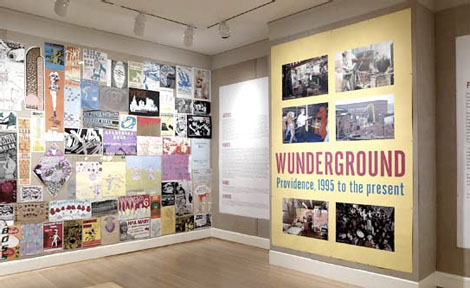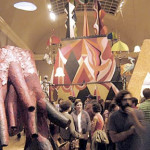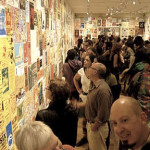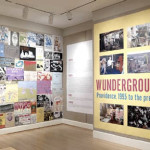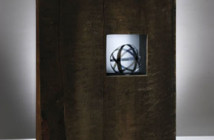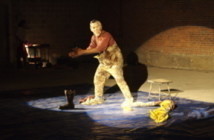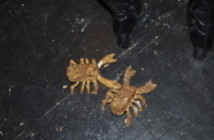Artist’s desire to create a better reality through alternative communities is not a new phenomenon. Indeed, it has been the goal of the avant-garde for the past century to merge art with everyday life through an alternate lifestyle. The artwork on view in Wunderground: Providence, 1995 to the Present, at the RISD Museum is broken into two exhibitions which explore this theme. Providence Poster Art 1995-2005 covers three galleries with eye-popping posters, silk-screen prints and photocopies from over 150 artists. An installation called Shangri-la-la-land fills the Museum’s central gallery with imagined worlds which attempt to create an alterna-village inspired by the artists’ collective living spaces.
The posters were made by the artists (mostly RISD students and graduates) who lived in Fort Thunder, an artist space founded in 1995 by Matt Brinkman and Brian Chippendale, in a run down mill building in the Olneyville neighborhood of West Providence. Organized by venue chronologically, the posters publicize local community events such as the Olneyville fair, underground concerts for bands like Mirah and Lightning Bolt, and art happenings such as Forcefield, which gained national acclaim in the 2002 Whitney Biennial. Hung floor-to-ceiling, the posters wallpaper the room with layers of information and texture, and highlight two core elements of the Providence scene: silkscreen and noise music. In addition, the posters are accompanied by listening stations that play recordings from the venues advertised in the show and add to the overall experience.
The walls vibrate with energy due to the fluorescent colors and complex patterns which pop off the flat surfaces. Looking at the posters is like entering the mind of the artists and exploring the fantastical settings they have created. Although the posters were produced to advertise events, the script is often deliberately illegible to mask information from outsiders. That the museum celebrates the once underground events marks a turning point in the history of the movement. It is refreshing to see icons of pop culture such as photocopied posters bumping up against the high culture within the museum.
The eight artists in Shangri-la-la Land attempt to recreate their studio space in collectives such as Fort Thunder through sculptural installations, which range in concept and scale. In order to reject capitalist society these underground artists fostered a counter-culture community which fought the power of marketplace by making things from found materials. Furthermore, the artists did not sell their work, but instead used it to create their own utopian reality. In their use of found materials and desire to live outside the system, the artists attempts to challenge our preconceptions of the value of art and its function in the marketplace. Each piece in the gallery shuns emerging technology in favor of a handmade, low-tech approach that exemplifies the artists’ belief in inexpensive living and art for life, not for sale. The most impressive piece is a 16 foot monster by Matt Brinkman, which moves and shakes periodically as the cable that tethers it to the wall rotates on a catch. The giant is unnerving because it dominates the entry space of the gallery and towers over the viewer with its spiked club. Unfortunately, in translating these creations to the institutional setting the installation fails to completely capture the worlds created in the dilapidated buildings. The magic of the alternate reality lies in the lifestyle as a whole, and by removing the art objects from the lifestyle, the emphasis falls on art as high culture object, and their core belief in art as life gets sidelined. Nonetheless, the work displays a creative spark alive and well within the underground scene.
Sadly, the independent lifestyle these artists sought to create was displaced by a development project which reclaimed their living spaces. The exhibition creates a second life for the radical art scene that has been forced to move from one illegal building to the next. Curator Judith Tannenbaum notes: "This exhibition provides an extraordinary window onto a thriving creative world whose art is seldom seen by mainstream museum-goers.” Hopefully, this glimpse into another world will inspire artists and museum-goers alike to continue to seek an alternate reality – one that pulsates with as much energy as the walls of the museum.
Links:
Fort Thunder (wikipedia)
Fort Thunder (official site)
See more images of the show in a slideshow format: RISD Museum
"Wunderground: Providence, 1995 to the Present " is on view until January 7th at the RISD Museum, in Providence, RI.
All images are courtesy of the artists, Erik Gould, Frank Mullin, and the RISD Museum.

